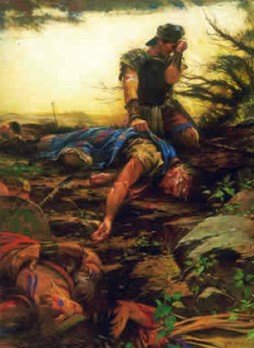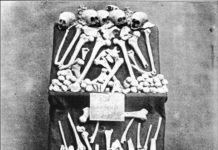Why do many insist that the final battle of the Nephites and Lamanites didn’t happen at the one and only Hill Cumorah? Many yell the words, “It’s a clean hill”, meaning there are no arrowheads found there, or they say, “where are all the bones?” Bones from 1,400 years ago that weren’t even buried? No breastplates or headplates? Ever hear of spoils of the war. Too small of a hill? The final battles didn’t happen just on a little hill, but in the Land of Cumorah. See Mormon 6:2. Oliver Cowdery said in Letter VII it was the hill of the final battles. Good enough for me. It makes sense. I believe the final battles happened in the Land of Cumorah, near the hill.
Below are two articles from Wayne May’s collection of information about bones found near Hill Cumorah. I ask people who believe in the Mesoamerican theory if they have found bones in their many possible locations in Mesoamerica including, Huimanguillo Tabasco, Yaxchilan, Palenque, Chiapa de Corzo, Quirigua, Santa Rosa, El Cayo, plus many other possible locations for Cumorah.
OUT OF THE DUST FINDING HUMAN REMAINS ON THE SAMPSON FARM
by Glen Ellis & Mark Ellis edited by Wayne N. May
Following up on the letter from J. Golden Barton from 1920 (Article at the end), here is a first-hand account from family members of the LDS community sharing a missionary experience while serving in the Palmyra, New York area during the1930’s and 1940’s. A second testimony of the “white dust” that was discussed by Apostle James E. Talmage and was recorded by the Ellis family in their journal. Permission to use this material was granted to myself, Wayne May, by Mark Ellis on April 6, 2018, while attending the Firm Foundation Presenting the 21st Book of Mormon Conference held at Layton, Utah.

“When I was plowing one day on the far end of the Sampson farm, (eastside of Hill Cumorah) Dad came by in the car, and suggested that I cross over the fence line into what had been he Bennett farm and plow up a field which had not been plowed for many years. I did so,and found the land to be exceptional, the soil was black and rich, the old Farmall H purred right along, pulling two 14” plows, which sunk into the maximum depth.

When you plow a field for the first time, you lay out the first furrow very carefully, because if that furrow is crooked, so will be all the subsequent ones. The trick is to walk off the distance from the corners of the piece to a post or tree in the middle of the far side fence, then measure the same distance from the corresponding fence corner to your tractor. They you keep your eye on that center post, lining up the radiator cap with the target post, just like aiming a gun. It works every time.
After the initial furrow is laid down nice and straight, you just keep one wheel in the furrow and they all come nice and straight, you can even look behind to enjoy the beautiful sight of the plow turning over matching black ribbons of soil. Getting back to the point of this tale, after about 6 or 7 rounds I looked back at the new sod turning, and to my amazement it suddenly turned over a milky white color for a distance of about 12 or 15 feet, then back to black! The next two rounds the same thing happened, so that there was a white patch about 12 to 15 feet long and about 6 to 8 feet wide. I scooped up a handful of the white material which Dad sent off to Cornell College in Ithaca, NY; they identified it as being ancient human bone material.
Glen Ellis told me many times that he was plowing the Sampson Farm on the “other side” of the Hill Cumorah when he found the strange soil. Normally he did not plow that area because it was too wet. One year, he was able to plow the Sampson Farm field and noticed that the soil was an odd color, but that it changed color soon after it was turned over. He told his dad (Merlin Ellis) about the soil, who collected some of the odd soil and turned it into Cornell “College.” The analysis reported the material to be human bone.
I suspect that Glen used an International Farmall and pulled a 2-bottom plow with about 14-inch plowing depth. Time frame would have been between 1938 to 1946, likely the latter time frame.
The color change is easy to interpret. The soil was highly organic and was frequently under water. As the organic material in the soil degrades and consumes the oxygen in the soil/water the soil becomes anoxic. Anaerobic degradation generates hydrogen sulfide (rotten egg gas) that is liberated when the soil is turned. The soil would have changed from black to a lighter color or even to white as the hydrogen sulfide volatilized, 15 minutes likely.
Locations? I don ‘t know where the Sampson Farm was located, but Glen indicated the “other side” of the Hill Cumorah was the location of the Sampson farm. The “other side” of the Hill could have been the east side of the Hill or the south end. I would look for anything that appears to normally be wet, saturated or marshy. So, I also attach a map of wetlands around the Hill (Cumorah), or I would also look at woodlands.” By Glen Ellis & Mark Ellis edited by Wayne N. May Ancient American Magazine CUMORAH LAND AMERICA’S ANCIENT HISTORY OF WESTERN NEW YORK LDS Special Edition VIII page 46:
[See map below from the Wayne County Journal of 1908 to see the Sampson Property]

James E. Talmage speaks out on Cumorah Land.
Elder James E. Talmage of the Council of the Twelve made the following statements to Elder Golden Jensen who was serving as secretary of the Eastern States Mission in New York in 1920, which Elder Jensen recorded in a letter to a friend in 1954:
Dear Brother Dixon: June 10, 1954 ,
In keeping with your request, I will endeavor to give you herein an account of an experience which I greatly enjoyed while laboring as secretary of the Eastern States Mission.
In the summer of 1920, 1 received an assignment to attend a special meeting with the missionaries laboring in Buffalo, New York. The day following the meeting I met George W. McCune, my mission president, and the late Dr. James E, Talmage who had driven to Buffalo from Detroit, Michigan. At their invitation I accompanied them to New York City. Enroute, however, we proceeded to Rochester, thence to the city of Palmyra, where we visited briefly. We then proceeded to the Joseph Smith Farm, where we left our car and walked to the sacred grove. As we were about to enter the grove, Dr. Talmage stopped, removed his shoes, and requested that President McCune and I remain where we were while he entered and prayed, alone in that sacred and holy spot, to the Living God.

After a while he called us to join him, whereupon he retold the story of the boy Prophet and of the glorious vision which Joseph had beheld, while President McCune and I sat and wept with joy.
Leaving the grove, we went immediately to the Hill Cumorah and viewed the spot where the Angel Moroni had, ages before, deposited the golden plates according to the instructions of the Lord. These records were later revealed and delivered to Joseph the Prophet and were translated by him forth to the world The Book of Mormon.
All the while I was being thrilled and edified by the continuous flow of information and wisdom that came from the marvelous store of knowledge of Elder Talmage. I think I shall never forget how he looked, standing with bared head on the crest of the Hill Cumorah and with outstretched arm describing as he seemed to visualize that last great battle between the armies of the Nephites and Lamanites, calling attention to the significance of the hill as a vantage point for the forces who might gain control or possession of it.
At this time he stated that he had found as a result of a survey and extensive analysis made by him, while a student in an eastern university, the soils of the surrounding area to be very rich in calcium, and phosphate content, in the soils particularly adjacent to the Hill Cumorah. With further investigation he discovered that there was a lack of these elements in the land which lay further than a few miles in radius in any direction from the Hill Cumorah. To him, this discovery was indicative of the fact that there was decaying of bones of the Nephite and Lamanite armies that perished there.
To Apostle Talmage there was no doubt as to the reality of those great events as related in the Book of Mormon, nor was there any doubt in his mind as to the place where they had occurred.
I commend you, Brother Dixon, for your keen interest in the visible and physical evidences which declare the truth of the Book of Mormon; and may the Lord bless you in your endeavor to bring attention of same to closer view.
Sincerely your brother, Golden Jensen
(Riley L. Dixon, Just One Cumorah, 1958, 147-149)
For more details about the artifacts found around Hill Cumorah read my other blog below;
About Bones and Swords
“In short, a bone is a living, self-maintaining, self-repairing organ—not an inert, cement-like substance that would tend to passively disintegrate with the passage of time.bone is quite resistant to degradation but will eventually be broken down by physical breaking, decalcification, and dissolution. The rate at which bone is degraded, however, is highly dependent on its surrounding environment. When soil is present, its destruction is influenced by both abiotic (water, temperature, soil type, and pH) and biotic (fauna and flora) agents.” Ken Saladin, Textbook author, human anatomy and physiology.
How long for a sword to decompose: “It mostly depends on where it’s been stored. Wood, leather and iron materials don’t do well with moisture. If left in the rain or in a moist humid place, after a few months The sword will be completely worthless. Is long as it’s kept in a dry relatively clean location away from scavengers, years. Most iron swords are found under the dirt or mud where they fell during battle, and are completely useless by the time they are found. The metal would survive intact the longest, and if the location is wet it’s best for to be either underground or underwater completely. Trust is a byproduct of oxidation, and water speeds up the process. Underwater the oxygen available is limited to whatever is suspended in water, so counterintuitively it’s better to be at the bottom of the lake then laying in a puddle.” Greg Pavelka, Biomedical Technician





